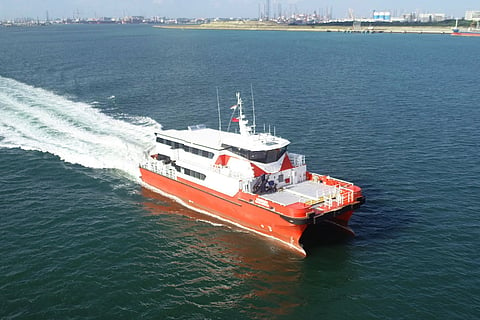

Taiwan is rapidly developing its offshore wind farm sector, so it obviously requires considerable OSV heft. British-based BMT came to the party with some very impressive and interesting design ideas that solve several problems experienced generally by windfarm support craft.
The basic, Singaporean-built, aluminium catamaran concept is not very new in the field. However, many of the features of Ventus Formosa and its sister ship are entirely new and make them really stand out from the wind farm OSV pack.
For 36-metre boats, their seven-day endurance is impressive, so also are their substantial ride control system and their BMT "active fender" arrangement that makes them so much more resilient when working around hard steel windmill towers.
The Ventus Marine partnership that specified and owned the boats should be very satisfied with them.
"The concept itself is special," James Lewis, BMT's sector lead for offshore energy, told Baird Maritime. "In a rapidly evolving industry the design of Ventus Formosa represents a new way of managing O&M demands. The purpose of the design is to plug the gap between a crewboat and a full-sized service operation vessel (SOV). Having the ability to stay out at the farm for a number of days improves the efficiency of O&M activities by removing the need for long passages to and from the farm every day."
Lewis was specifically referring to the crewboat's ability to double as an accommodation vessel, and it is aided in this regard by 12 onboard single cabins with en suite bathrooms, media entertainment, and reduced noise levels.
Having one platform operating in two diverse but closely related roles is just one indication of what Lewis described as the drive towards greener vessel designs prevalent in the offshore industry.
"It's a really interesting time and we can see many noteworthy concept designs being released. This can mean many things and naturally encompasses innovative hull designs, alternative fuels or a general drive towards electrification.
"We have also recently seen the new [IMO] Tier III emission regulations come into force from the first of January. This applies to Northern Europe and means that we now incorporate SCR exhaust systems into our engine room designs to meet the new regulations."
Getting these and other concepts off the ground was made especially challenging by Covid-19, but BMT remained as busy as ever. The company's office staff were compelled to switch to remote working virtually overnight and there have even been delays in certain projects, but the team learned to finally settle into the new normal and went about meeting all its other targets.
"On the whole," remarked Lewis, "we see very encouraging signs of an industry that is showing real robustness in extraordinary times. This is especially true for the offshore wind industry. It seems to be going from strength to strength, with new windfarm developments being announced regularly around the world.
"It is clear that the future is very bright for offshore wind. Europe is going from strength to strength, Taiwan and Japan are very active and the US has big plans. There seems to be a trend in Europe for farms to go further and further offshore."
Lewis added that vast improvements are also being made in turbine technology, with 14MW turbines now available whereas the UK's first offshore windfarm was put up with 2MW turbines installed.
"These developments," Lewis told Baird Maritime, "all point to slightly shifting requirements for windfarm service vessels, depending on what farm and in what part of the world they are needed. Clearly there's a limit to the length a daily commute can be to and from a wind farm every day. This is what will fuel the demand for Ventus Formosa and other large vessels that don't need to be a slave to the daily commute."
Besides the need for greater capacity, greener vessel design is another area of focus for BMT. This will also apply to existing vessels that will be refit and re-engineered to lower their carbon footprint. Towards this end, the company is exploring opportunities in areas such as hybrid power and electrification, alternative fuels, optimising the efficiency of current installations, and the introduction of exhaust treatment systems.
